APPX 5.5.0 Features - System Administration
This page describes the new features in Application DesignNew Environment Variables
Some new environment variables have been added in this release: APPX_SCREEN_ROWS - Sets the default number of rows for use when adding a new Input.APPX_SCREEN_COLS - Sets the default number of columns for use when adding a new Input.
APPX_DATASVC_LOG - Sets the path & file name of the debug log for the new Data API
APPX_EXPERIMENTAL_PROCESS_DESIGN - Activates a prototype Input editor in Application Design
APPX_KEEP_FMS1 - Changes the default FMS type back to 1 instead of 9
APPX_EMAIL_LOG - Sets the path & file name of the debug log for the new Email API
APPX_DOC_ON_ADD - Causes APPX to display the new HTML documentation screen automatically when adding objects.
APPX_USE_OLD_ITEM_EDIT - Causes APPX to use the old Item editor See the Environment Variable wizard at https://www.appx.com/wizard
New files created with FMS type 9 automatically
When a new file is added to an application, it will default to a FMS type 9 (large file format) automatically. This eliminates the possiblity of hitting the 4G file limit on a file. To set the default back to FMS type 1, set the environment variable APPX_KEEP_FMS1 to any non blank value.Inactive flag on User File
An 'Inactive' flag has been added to the User file: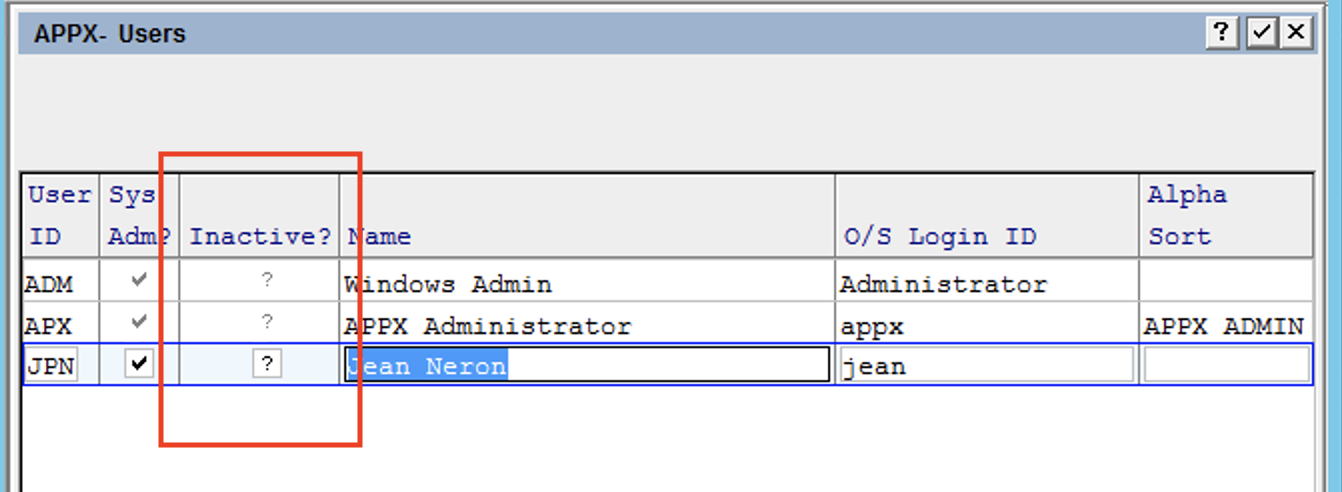 A blank or N value means the user can log in. If this field is checked, then the user will receive an 'Invalid User or Password' error when they try to log in.
A blank or N value means the user can log in. If this field is checked, then the user will receive an 'Invalid User or Password' error when they try to log in.
Design File Management
Design File Management has been enhanced to allow you to leave out the Application, Version or both. Anytime you are prompted for an Application / Version, you can:- Leave Application blank and APPX will select all Applications in the specified Version
- Leave Version blank and APPX will select all Versions of the specified Application
- Leave both blank, and APPX will select All Applications, All Versions.
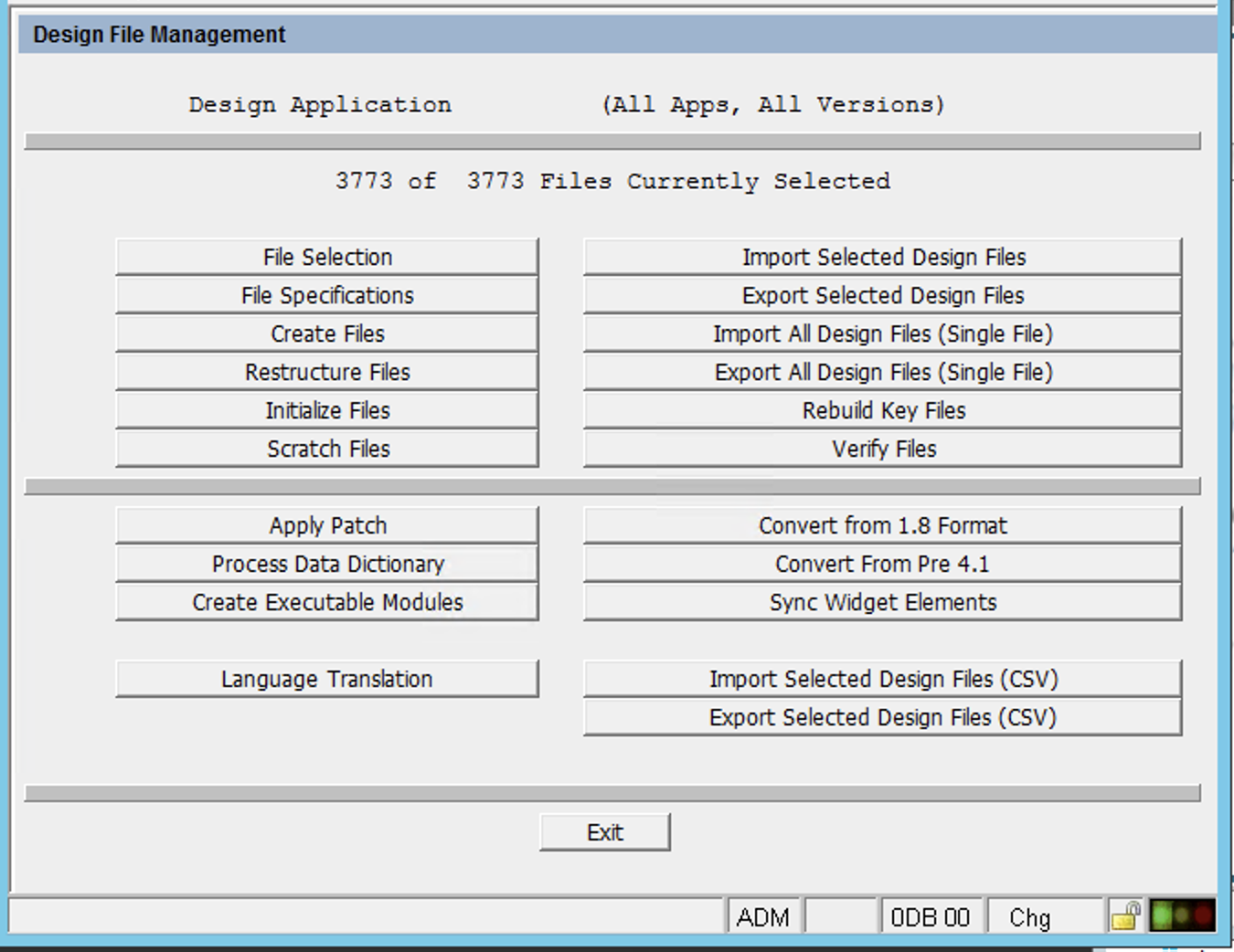 When multiple Applications are selected, some options are not allowed:
When multiple Applications are selected, some options are not allowed: -
Import All Design Files (Single File)
- Export All Design Files (Single File)
- Apply Patch
- Convert from 1.8 Format
- Convert From Pre 4.1
- Language Translation
Data file management
Data File Management has been enhanced to allow you to leave out the Application, Database or both. Anytime you are prompted for an Application / Database, you can:- Leave Application blank and APPX will select all Applications in the specified Database
- Leave Database blank and APPX will select all Databases that use the specified Application
- Leave both blank, and APPX will select All Applications, All Databases.
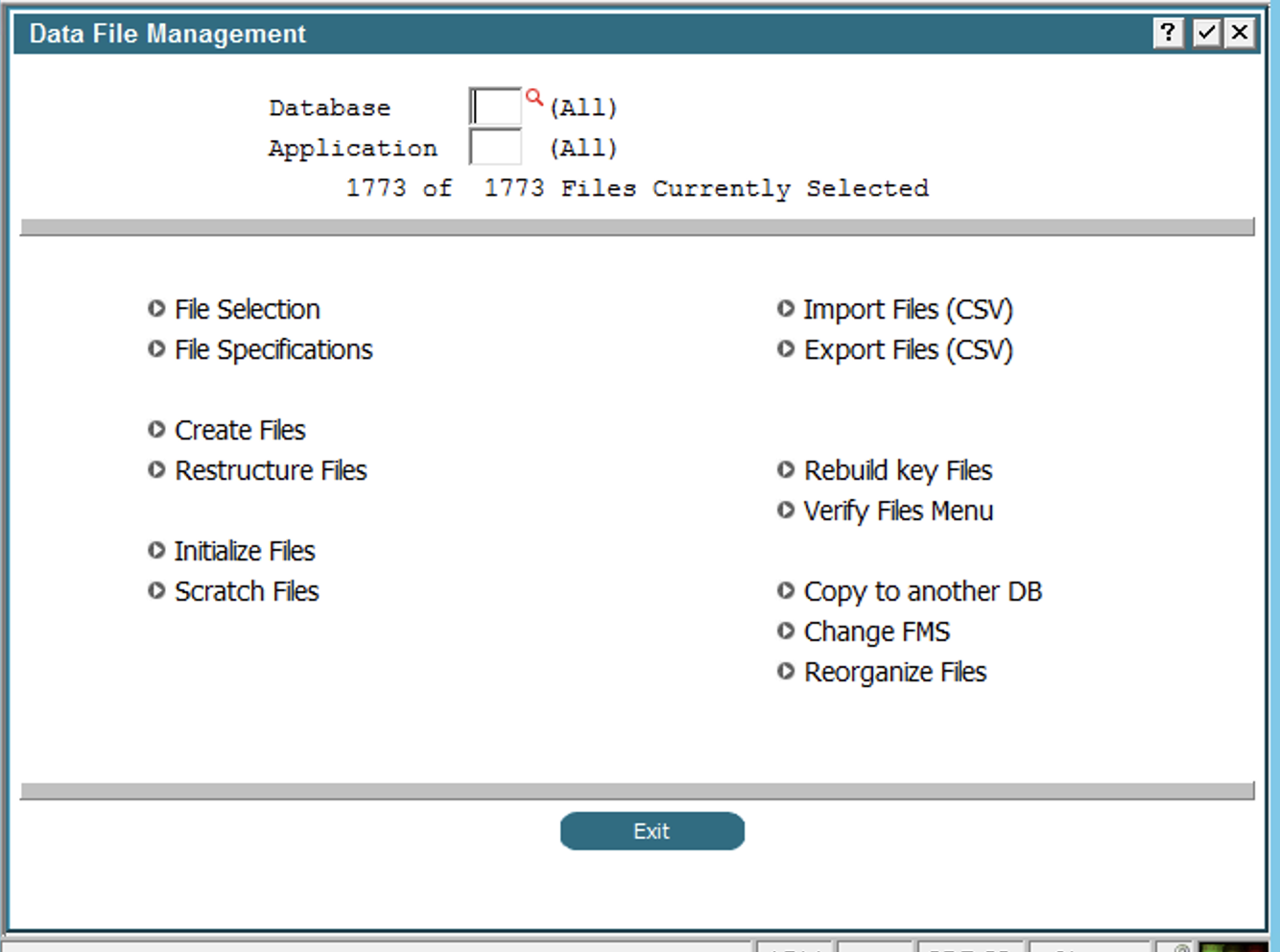 In addition, some new features have been added:
In addition, some new features have been added: - 'Copy to another DB'. This allows you to copy the data files from one Database to another. You can select one or multiple applications. The copy is accomplished by a CSV export from the source Database and then a CSV Import into the target Database. The record counts are logged, and if there are any discrepencies, it will be noted after the export/import is complete. This approach allows data to be copied between different FMS types, ie, the source Database could be using APPX/IO and the target Database could be using Oracle. You can only use this option when a single Database is selected.
- 'Change FMS' allows you to change the FMS type for the selected files. You can do this with or without data conversion. For example, to move all files to SQL Server you would use this with the 'Convert Files' option. The data would be exported, the FMS type changed to the new setting, and the data imported. Record counts of the exported / imported data are compared and any discrepencies are reported. Another example could be if you copy APPX/IO data files from another version of APPX and they are in the older FMS type 1 format, but the file specifications on the new server indicates they should be FMS type 9. You can use this option without the 'Convert Files' flag to change the FMS type from 9 to 1. Since the data is already in FMS type 1 format, you do not want APPX to convert them.
- 'Reorganize Files'. This simply does an export/import of the selected files. The record counts are compared and any discrepencies are reported. This will remove all deleted records from the selected files, and possibly improve performance.
File Selection Enhanced
Since you can now select mutiple Databases, Applications, and Versions in Data/Design File Management, we also enhanced the File Selection capability. The 'Go To' has more fields: The key to the list of files is Database/Application/Version and Name. This allows you to go to a specific key. Design Files do not have a Database, so you would leave that blank, but fill in the App/Ver/Name. Data files have a Database, so you would have to fill in all key parts.
The 'Select' button also has some additional fields:
The key to the list of files is Database/Application/Version and Name. This allows you to go to a specific key. Design Files do not have a Database, so you would leave that blank, but fill in the App/Ver/Name. Data files have a Database, so you would have to fill in all key parts.
The 'Select' button also has some additional fields:
 'Category' is only applicable to Data files. Category refers to the Category you entered in the Additional Attributes of the file in the Data Dictionary. The SCAN icon will show you a list of all the Categories found in the selected files. All fields are ANDed together to find matches. For example, if you only entered 'CUSTOMER' as a file name, then all files named 'CUSTOMER' would be selected. If you also entered a Database, then only files named 'CUSTOMER' in the specified database would be selected, regardless of Application. Or if you initially chose a particular Application, all Databases, then you could use this to select 'CUSTOMER' in all Databases.
You will be positioned to the first selected file, and a count of the selected files is displayed.
This example shows all PARAM files in all Applications for Database GAP:
'Category' is only applicable to Data files. Category refers to the Category you entered in the Additional Attributes of the file in the Data Dictionary. The SCAN icon will show you a list of all the Categories found in the selected files. All fields are ANDed together to find matches. For example, if you only entered 'CUSTOMER' as a file name, then all files named 'CUSTOMER' would be selected. If you also entered a Database, then only files named 'CUSTOMER' in the specified database would be selected, regardless of Application. Or if you initially chose a particular Application, all Databases, then you could use this to select 'CUSTOMER' in all Databases.
You will be positioned to the first selected file, and a count of the selected files is displayed.
This example shows all PARAM files in all Applications for Database GAP:
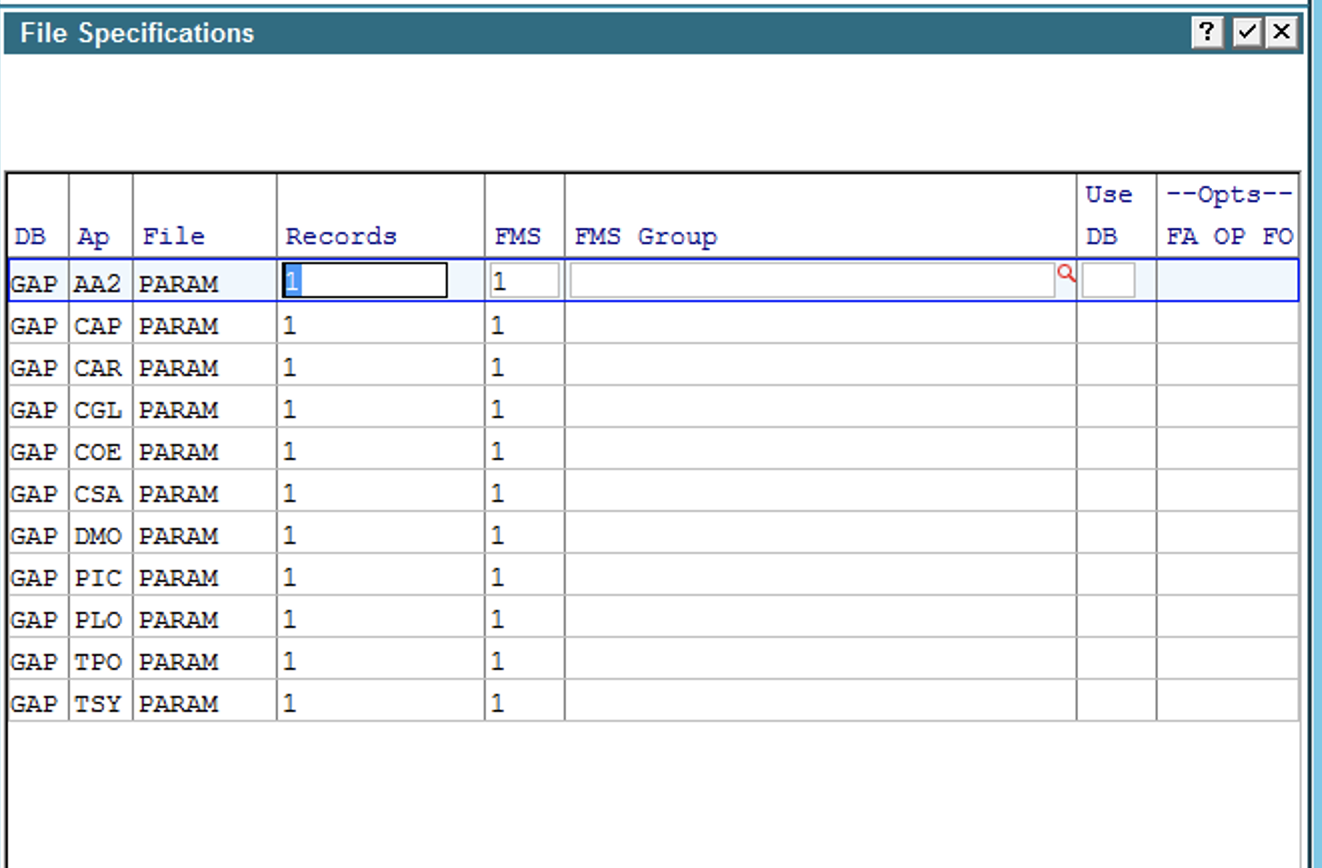
Monitor Application Shows User Stack
The Monitor application (System Administration -> System Setup -> Monitor Appx Sessions) has been enhanced to show the stack, ie, the parents/grandparents/etc of the current process. This can be helpful when the Monitor shows that the user is in a SCAN process, or PRINT ON SCREEN. By looking at the stack, you can see what actual process they are running. To see the stack, simply double click on a user on the Monitor display: In this example, the main Monitor display just shows that the user is running 'NSCAN TABLE (110)', but by double clicking their row, we can see that they are running the CUSTOMERS input in the Order Entry application, which gives us a much better idea of what they are doing.
Note that the Monitor display also now shows the type of client (Java or HTML).
In this example, the main Monitor display just shows that the user is running 'NSCAN TABLE (110)', but by double clicking their row, we can see that they are running the CUSTOMERS input in the Order Entry application, which gives us a much better idea of what they are doing.
Note that the Monitor display also now shows the type of client (Java or HTML).
Email Distribution Lists
This release includes the ability to Email a report directly from APPX (requires the 'mutt' email client). Reports can be emailed directly to email addresses, or you can set up distribution lists and use those. Email Distribution lists can be found under System Administration -> Configuration -> Email Distribution. To add a new list, click the 'Add' button: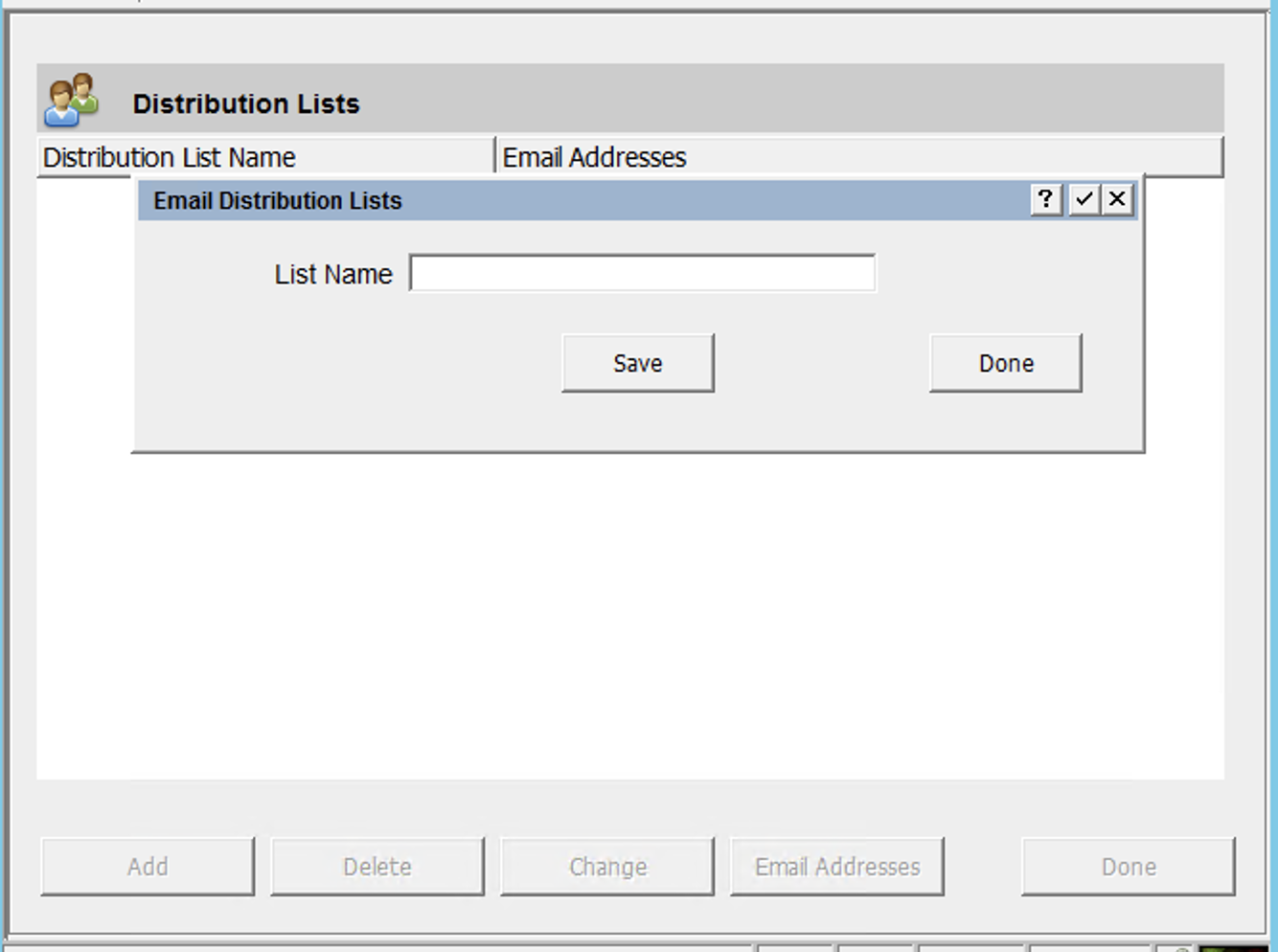 Once you enter a list name and click 'Save', you will see the list of individual email addresses:
Once you enter a list name and click 'Save', you will see the list of individual email addresses:
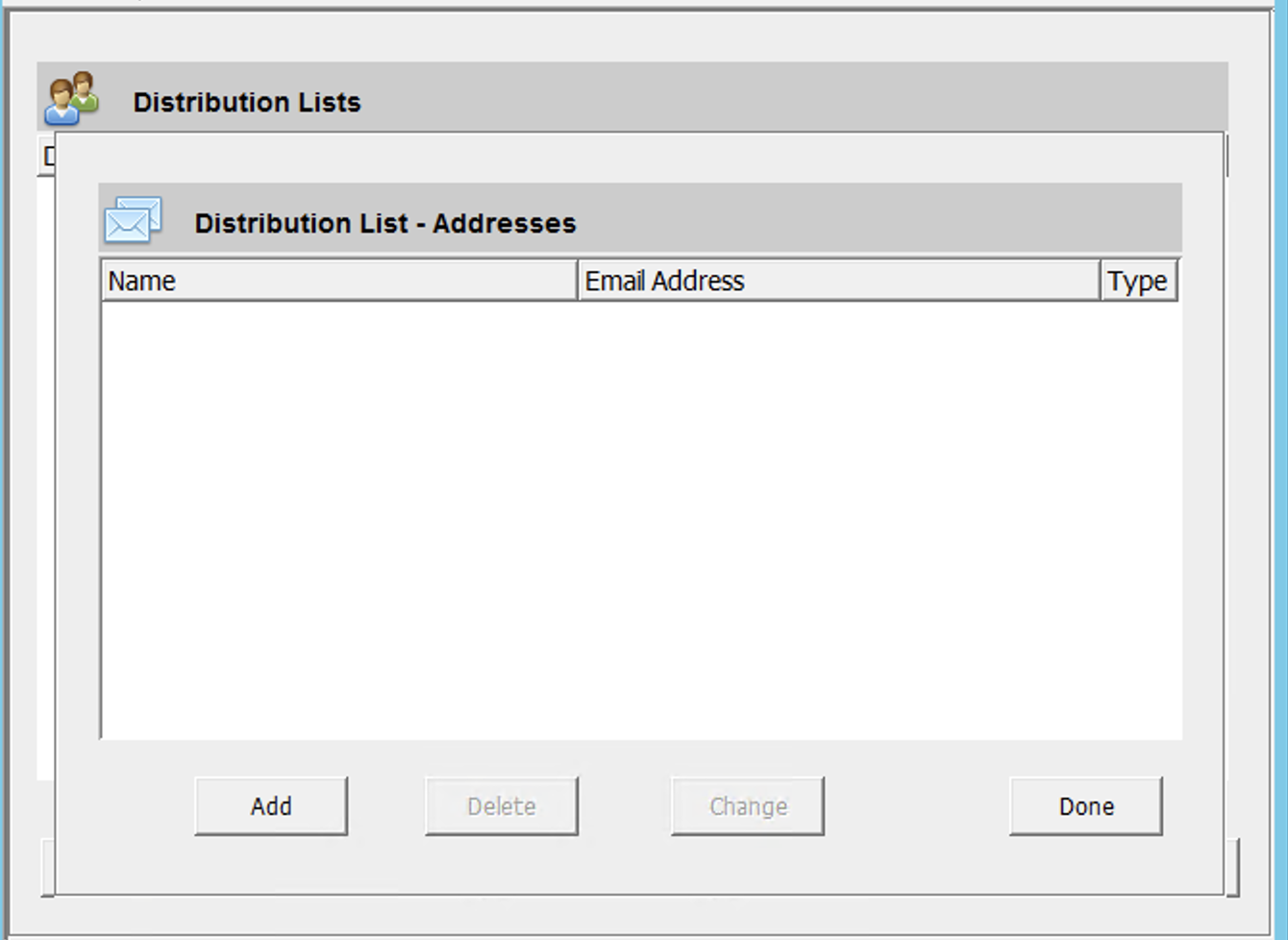 This will be initially blank, so click 'Add' to add the first email address:
This will be initially blank, so click 'Add' to add the first email address:
 The 'Name' is optional, and if filled in, should be the recipients name. The drop down list allows you to choose if they are 'To', 'CC', or 'BCC'. Add as many email addresses as needed.
To delete or change an existing email address, select the address and then click Delete or Change.
To delete or change an entire distribution list, exit the list of email addresses, select the distribution list and then click Delete or Change as required.
These distribution lists will be then be available for users to choose on the new Print Disposition screen.
--
The 'Name' is optional, and if filled in, should be the recipients name. The drop down list allows you to choose if they are 'To', 'CC', or 'BCC'. Add as many email addresses as needed.
To delete or change an existing email address, select the address and then click Delete or Change.
To delete or change an entire distribution list, exit the list of email addresses, select the distribution list and then click Delete or Change as required.
These distribution lists will be then be available for users to choose on the new Print Disposition screen.
-- Comments
Ideas, requests, problems regarding TWiki? Send feedback

